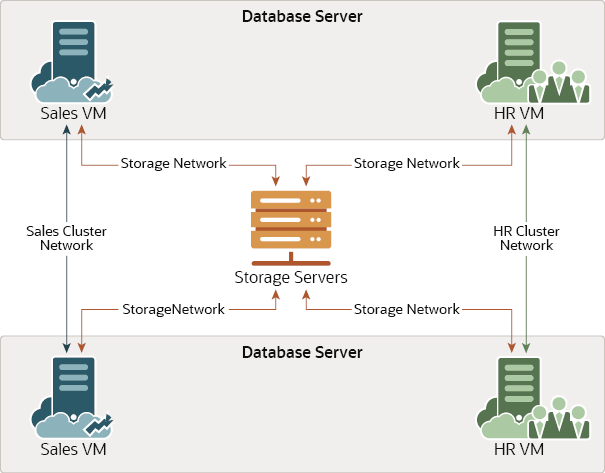6.22 Using Exadata Secure RDMA Fabric Isolation with Oracle Linux KVM
This topic describes the implementation of Exadata Secure RDMA Fabric Isolation in conjunction with Oracle Linux KVM.
Secure Fabric enables secure consolidation and strict isolation between multiple tenants on Oracle Exadata. Each tenant resides in their own dedicated virtual machine (VM) cluster, using database server VMs running on Oracle Linux KVM.
With Secure Fabric, each database cluster uses a dedicated network partition and VLAN ID for cluster networking between the database servers, which supports Oracle Real Application Clusters (Oracle RAC) inter-node messaging. In this partition, all of the database servers are full members. They can communicate freely within the partition but cannot communicate with database servers in other partitions.
Another partition, with a separate VLAN ID, supports the storage network partition. The storage servers are full members in the storage network partition, and every database server VM is also a limited member. By using the storage network partition:
- Each database server can communicate with all of the storage servers.
- Each storage server can communicate with all of the database servers that they support.
- Storage servers can communicate directly with each other to perform cell-to-cell operations.
The following diagram illustrates the network partitions that support Exadata Secure RDMA Fabric Isolation. In the diagram, the line connecting the Sales VMs illustrates the Sales cluster network. The Sales cluster network is the dedicated network partition that supports cluster communication between the Sales VMs. The line connecting the HR VMs illustrates the HR cluster network. The HR cluster network is another dedicated network partition that supports cluster communication between the HR VMs. The lines connecting the database server VMs (Sales and HR) to the storage servers illustrate the storage network. The storage network is the shared network partition that supports communications between the database server VMs and the storage servers. But, it does not allow communication between the Sales and HR clusters.
Figure 6-3 Secure Fabric Network Partitions

Description of "Figure 6-3 Secure Fabric Network Partitions"
As illustrated in the diagram, each database server (KVM host) can support multiple VMs in separate database clusters. However, Secure Fabric does not support configurations where one database server contains multiple VMs belonging to the same database cluster. In other words, using the preceding example, one database server cannot support multiple Sales VMs or multiple HR VMs.
To support the cluster network partition and the storage network partition, each database server VM is plumbed with 4 virtual interfaces:
clre0andclre1support the cluster network partition.-
stre0andstre1support the storage network partition.Corresponding
stre0andstre1interfaces are also plumbed on each storage server.
On each server, the RoCE network interface card acts like a switch on the hypervisor, which performs VLAN tag enforcement. Since this is done at the KVM host level, cluster isolation cannot be bypassed by any software exploits or misconfiguration on the database server VMs.
You can only enable Secure Fabric as part of the initial system deployment using Oracle Exadata Deployment Assistant (OEDA). You cannot enable Secure Fabric on an existing system without wiping the system and re-deploying it using OEDA. When enabled, Secure Fabric applies to all servers and clusters that share the same RoCE Network Fabric.
Related Topics
Parent topic: Managing Oracle Linux KVM Guests